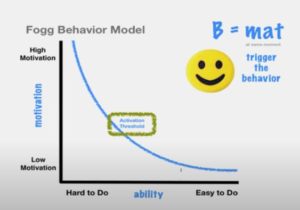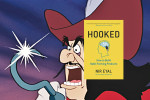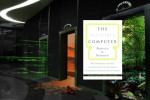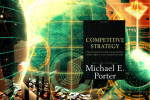Habit Design
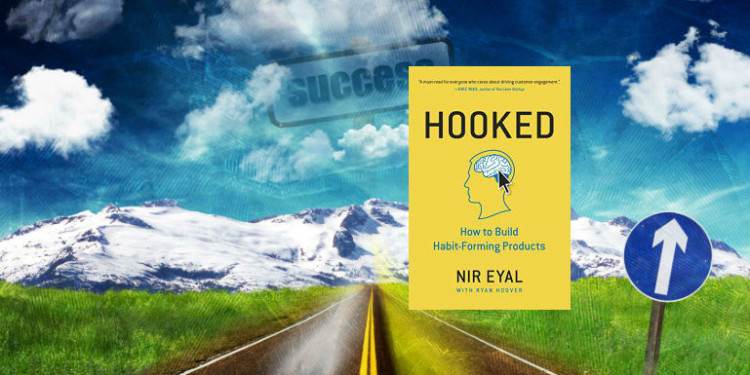
Hooked: How to Build Habit-Forming Products by Nir Eyal
Initiating a behavior requires a trigger, motivation, and ability. To get users over this threshold, start with making your product or service easier to user (increase ability). It is much harder to create motivation.
In Hooked author Nir Eyal introduces BJ Fogg’s Behavioral Model. The Fogg Behavioral Model says that “a given behavior will occur when motivation, ability, and a trigger are present at the same time and in sufficient degree.” Fogg’s model is a key part of Eyal’s framework because it describes how a product designer can achieve getting users to perform behaviors. More importantly, it provides a diagnostic tool that helps situate a product’s current state and provides the trajectory for success.
If you design for outcomes, you are designing for the wrong place. You need to design for the behaviors that lead to the outcome.
Fogg identifies opposite ends of the behavior spectrum which designers attempt to reach. On one end are abstractions such as “lose weight” and “be healthy.” On the other end are specific actions which are often too difficult for the end user to perform. It’s better to start by designing for specific behaviors which can be measured. This helps situate behaviors at the right level of granularity.
Sitting in full lotus and swimming are two examples of the incorrect design perspective. In both cases, the goal is a complex physical behavior. No amount of motivation (e.g., money) or encouragement will enable the person attempting the behavior to do it better. He offers an audience member $5 to sit in full lotus, simulating the “motivation” that many on-line services employ. Outcomes such as “being healthy” and “losing weight” are at least as complicated as swimming. Therefore, there is a learning progression to achieve them. Designers must create step-by-step solutions to help people through the process to meet these desired outcomes.
Look at your products. Are you helping people step by step do what they already want to do?
Fogg wants to replace the idea of “creating a system to motivate behavior change” with “facilitating behavior change.” Motivation is not the only key to behavior change.
Simplicity changes behavior in the long term. What matters more is making things easy to do, step by step
If a person is using your product or service for a goal such as losing weight and they fail, that is not a “neutral event.” Fogg says that failure will hurt the person as it will decrease impact them in the moment and hurt their chances of being successful in the future.
Talk about behaviors, not abstractions
If we could get our users to do anything, what would we have them do?
Having a conversation about behaviors is more helpful for product teams than discussing high level concepts such as “engagement” and “being the leading platform for X.” Instead of talking about abstractions, ask: What behaviors do you want people to do? Fogg uses his “magic wand” exercise to consider: “if we could get our users to do anything, what would we have them do?”
What behavior are you targeting and how will you trigger it?
Behavior = Motivation + Ability + Trigger
A trigger is call to action: “do it now”. Motivation can be high or low; ability can be easy or hard. We want people to be motivated and we want it to be easy so that when the trigger occurs, they do it. If they don’t know who we are and find out product/service difficult, then they will not do the behavior.
Fogg realized that the most effective type of trigger is an existing behavior. When you use an existing behavior as a trigger for a tiny habit, you are using an existing element of your life and don’t have to introduce anything new.
The right combination of motivation and ability when triggered, will cause the desired behavior by moving the user across the threshold. If the threshold is not met, then the behavior will not occur.
The Behavior Grid
Fogg has another framework which is the behavior grid. It enables you to plot a spectrum of activities you want your customer to do: something new, something familiar, stop behavior. If you want them to do something new one time you can deceive them or motivate them. If you want them to do something over and over, there is a different formula to use for each time. To get them to stop, take away the motivation, take away the behavior. Fogg’s key message here is that not all behaviors are the same.
If something is too hard, no amount of motivation will be sufficient. Rather than boosting motivation, make it easier to get your users over the threshold. Frustration lives where the activity is difficult but motivation is blaring at you.
Consider clicking on a banner ad. You don’t really want to do it. No matter how many times a banner ad asks you to click on it, you won’t. Annoyance lives here.
Getting people over the threshold
Simplicity matters more than motivation
Although our first instinct is to motivate, the correct first step is to make sure we as designers are providing a trigger. The second step is to make the activity easier. The third and final priority is to motivate. Motivation is a very difficult level to pull because it’s hard to know what motivates one person versus another. Conversely, if you make something easier it doesn’t revert and get harder again.
Behavior change does not equal “we need to motivate people.” Instead, first ask: “Who is already above the curve (has motivation and the activity is easy) and how do we trigger them?” Your second priority should be to trigger motivated people but who find it hard. Make it easier for them. Finally, work with people who don’t want to do it but the activity is easy. Don’t bother with the ones who have no motivation and where the activity is hard.
Every winning product or service will help people do what they already want to do
Is there any product which made people do something they don’t want to do? In a successful product, if the desired behavior happened, ask what triggered it? If I did something, there must have been sufficient motivation and it must have been easy to do. If it didn’t happen, ask which of the three was missing?
Tiny Habits
Rather than throw people in the deep end and expect them to swim, Fogg advocates giving them something really easy to do. This enables you to utilize a very low level of motivation to achieve the desired behavior. As motivation waxes and wanes, the effect on the behavior will be minimal because the activity (e.g., walk five minutes a day) is so easy to do. Habits are created through achieving a series of very small and easy activities rather than attempting to “grind it out” with high levels of motivation.
Tiny habits live in the lower right section of the behavior graph because they are easy to do and and require little motivation.
By setting tiny habits, people quickly get a very high sense of accomplishment. Fogg says that this success builds and enables people to take on much more difficult challenges. He concludes by saying that although the context around humans is often very complex, human behavior is not.
